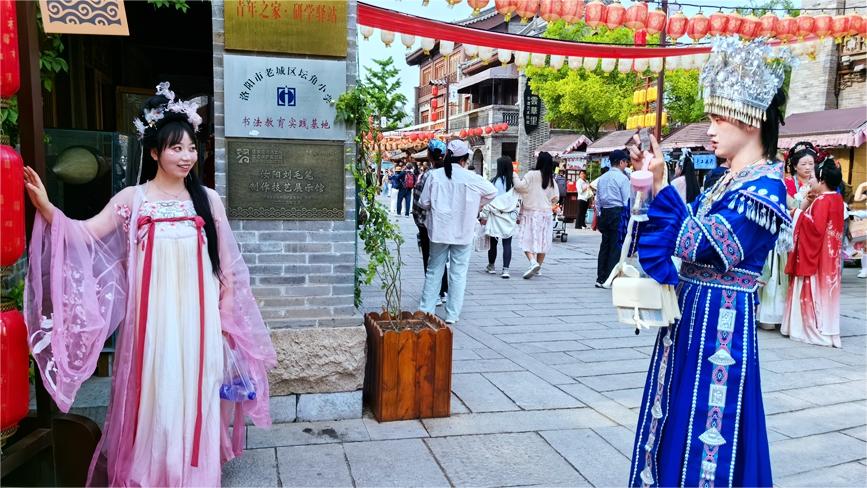Letter from China: Two types of weaving machine tell story of China's industrial upgrading
NANJING, May 5 (Xinhua) -- In my recent visit to the city of Wuxi, a private business hub, a decaying wooden weaving loom, now a museum exhibit emblematic of a local firm's humble beginnings, grabbed my attention.
It was one of the eight weaving looms the local apparel producer HOdo Group used to kick-start its journey from a small township enterprise in the 1980s, to a listed conglomerate and a global player today.
It attracted my attention because it stood in striking contrast with how the textile factory looks today.
The wooden weaving looms vanished from HOdo Group's factories, replaced by automated and intelligent machinery for tasks ranging from knitting to cutting and sewing.
HOdo has upgraded its production lines for smarter manufacturing. Walking into its 5G-enabled suit plant, I saw hundreds of thousands of pieces of clothing-in-the-making automatically moving along the overhead tracks, with workers taking down a certain number of pieces that are commensurate with their capacity.
A giant screen displays a wide array of data concerning the 5G intelligent factory, such as real-time order analysis, on-the-ground production progress, inventory turnover, and a layout of all the working stations.
The overall efficiency of production in the suit plant has been boosted by 32 percent, said Wang Zhuqian, chairman of the board of supervisors of HOdo, adding the smart retrofitting brought a byproduct -- that more young people are willing to work on their production lines.
HOdo has also introduced state-of-the-art technologies into the old trade of tailors. It has been jointly developing a laser precision tailoring machine with a tech company.
I stepped into the machine cabin and pressed a button, and all my precise measurements were displayed on the screen together with a 3D modeling of my figure. The data can be transferred to the suit plant to make a bespoke suit.
HOdo is among the enterprises in traditional industries that are boosting investment in technological upgrading and pursuing innovation-driven growth.
The original weaving loom of HOdo aroused my interest for an additional reason: it reminded me of another type of weaving machine I came across when visiting a high-tech company, Huangshi Grace Fabric Technology Co., Ltd, situated in Huangshi of Hubei Province.
In a plant the size of a football pitch, 416 weaving looms, attended by a dozen workers or so, are rapidly turning out woven fabric. The fabric, as soft as regular cloth, is heat-resistant, insulating E-cloth eventually used in circuit boards, woven with fiberglass yarns.
Picturing these two types of weaving looms in juxtaposition, I was startled to find that the country's manufacturing industry had come a long way.
The two types of weaving machines, one employed in the traditional textile industry and the other in the high-tech industry, offer a glimpse into a larger picture of China's industrial upgrading.
A larger share of the manufacturing industry pivots to tech-intensive and higher value-added sectors. "Made in China" is no longer a byword for low-end goods.
Rather, "made in China" could be Grace Fabric's world-leading 3.5-micron fiberglass yarn and the E-cloth made with it. It could also be new energy vehicles, AI-enabled robots, or other futuristic devices.
According to official statistics, the high-tech manufacturing sector registered a growth of 7.5 percent in Q1, accelerating by 2.6 percentage points from the fourth quarter of 2023.
Investment in high-tech industries has experienced robust growth, increasing by 11.4 percent from the previous year. In particular, investment in high-tech manufacturing expanded by 10.8 percent.
With the rise of high-tech manufacturing and technological upgrading of traditional industries, the landscape of the manufacturing industry in China will continue to be transformed.
Photos
Related Stories
- Total listed manufacturing companies in China reaches 3,629 by end March 2024
- Ethiopia expects more Chinese investments in manufacturing sector
- Advanced manufacturing new magnet for foreign-invested firms amid industrial upgrade
- Commentary: Hidden agenda behind hype of China's "overcapacity problem"
- China's manufacturing activity recovers in March
Copyright © 2024 People's Daily Online. All Rights Reserved.









